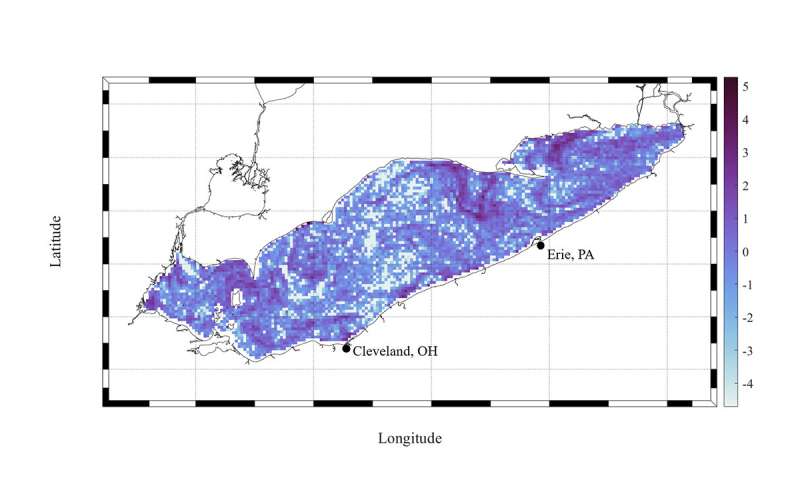by Luke Auburn, Rochester Institute of Technology

RIT scientists developed the first three-dimensional model to show where microplastic pollution is collecting in Lake Erie. This figure is the result of a half-year model simulation of particle count distribution in the lake's open water. Credit: RIT
Rochester Institute of Technology scientists have developed the first three-dimensional mass estimate to show where microplastic pollution is collecting in Lake Erie. The study examines nine different types of polymers that are believed to account for 75 percent of the world's plastic waste.
Plastic behaves differently in lakes than in oceans; previous studies on both have indicated the levels of plastic pollution found on the surface are lower than expected based on how much is entering the water. While massive floating "islands" of accumulated plastic waste have been found in oceans, previous studies have indicated the levels of plastic pollution found on the surface of Lake Erie are lower than expected based on how much is entering the water.
The new RIT estimate for the 3-D mass—381 metric tons—is more than 50 times greater than the previous estimates at the surface. The study also generated the first estimate of how much plastic is deposited on the bottom of the lake. It accounts for the unique properties of different types of plastics and shows that the three polymers with the lowest density—polyethylene, polypropylene and expanded polystyrene—accumulate on the surface of the lake while the other six polymers were concentrated in the sediment.
"Previously there was a focus on plastics modeled as neutrally buoyant for the most part in the beginning of plastics modeling," said Juliette Daily, a mathematical modeling Ph.D. student and author of the study. "In reality, plastic is probably almost never neutrally buoyant. It's probably always positively or negatively buoyant, which really changes how the particles behave."
The study shows other interesting patterns, such as plastic particles accumulating more heavily on the eastern shore of the lake, perhaps from the current moving predominantly west to east. This means that pollution could be pushed disproportionately to areas like Buffalo, N.Y. The authors hope other researchers will continue to build on this research and explore how factors like beaching can further explain where plastic particles end up.
"Trying to understand where plastic is going is important for people looking at mitigation or prevention and will be important for understanding what the most likely impacted areas are," said Matthew Hoffman, associate professor in the School of Mathematical Sciences and co-author of the paper. "Looking at things in the sediment or getting an idea of what is down in the lower levels of the lake will give us a better idea of what concentrations there are and what possible exposure levels are to this ecosystem."
The study is published in the May 2020 edition of the Marine Pollution Bulletin.
Explore furtherResearchers estimate 10,000 metric tons of plastic enter Great Lakes every year
More information: Juliette Daily et al, Modeling the three-dimensional transport and distribution of multiple microplastic polymer types in Lake Erie, Marine Pollution Bulletin (2020). DOI: 10.1016/j.marpolbul.2020.111024
Journal information: Marine Pollution Bulletin
Provided by Rochester Institute of Technology
No comments:
Post a Comment